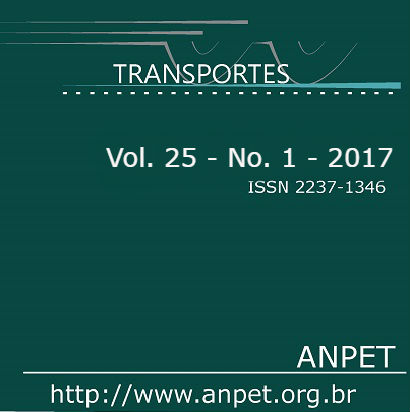Uma proposta de solução para o Aircraft Recovery Problem de companhias aéreas regulares de pequeno porte
DOI:
https://doi.org/10.14295/transportes.v25i1.1265Keywords:
Gestão das interrupções, aviação civil, Aircraft Recovery Problem, otimização.Abstract
A resolução do Aircraft Recovery Problem consiste em redefinir o sequenciamento das aeronaves, após interrup- ções das operações, que implique no menor custo operacional às companhias aéreas de voos regulares. O método adotado neste trabalho baseou-se na construção de uma rede tempo-espaço a partir dos dados de pousos e decolagens de uma companhia aérea brasileira. O modelo matemático do fluxo de custo mínimo foi implementado para o problema, o qual foi resolvido via Programação Linear Inteira. Foram realizados testes computacionais com centenas de instâncias e os resultados obtidos sugerem que a abordagem proposta é capaz de encontrar soluções melhores quando comparados com a simples estratégia de cancelar os voos atribuídos às aeronaves indisponíveis. Também foram realizados testes adicionais para verificar o impacto do fornecimento de uma aeronave extra no aeroporto com o maior número de voos operados pela companhia aérea estudada.Downloads
References
ARGÜELLO, Michael F.; BARD, Jonathan F.; YU, Gang (1997a). A GRASP
for aircraft routing in response to groundings and delays. Journal of Combinatorial Optimization, v. 1, n. 3, p. 211-228. DOI: 10.1023/A:1009772208981.
ARGÜELLO, Michael F.; BARD, Jonathan F.; YU, Gang (1998b). Models and methods for managing airline irregular operations. In: Operations Research in the Airline Industry. Springer US, p. 1-45. DOI: 10.1007/978-1-4615-5501-8_1.
ANAC (2013). Anuário do Transporte Aéreo: Dados Estatísticos e Econômicos de 2013. Brasília: Anac, 207 p.
BARD, Jonathan F.; YU, Gang; ARGUELLO, Michael F (2001). Optimizing
aircraft routings in response to groundings and delays. IIE Transactions, v. 33, n. 10, p. 931-947. DOI: 10.1080/07408170108936885.
BAZARGAN, Massoud (2012). Airline operations and scheduling. Ashgate Publishing, Ltd.
BISAILLON, Serge et al. (2011). A large neighbourhood search heuristic for the aircraft and passenger recovery problem. 4OR, v. 9, n. 2, p. 139-157. DOI: 10.1007/s10288-010-0145-5.
BELOBABA, Peter; ODONI, Amedeo; BARNHART, Cynthia (2009). The global airline industry. John Wiley & Sons. DOI:10.1002/9780470744734.
BRASIL (1986a). Lei nº 7565, 9 de dezembro de 1986. Código Brasileiro de Aeronáutica. Brasília.
BRASIL (2000b). Agência Nacional de Aviação Civil. IAC 1223, 19 de janeiro de 2000. Normas para confecção e aprovação de HOTRAN. Rio de Janeiro.
BRASIL (2000c). Agência Nacional de Aviação Civil. IAC 1224, 19 de janeiro de 2000. Normas para alterações em voos regulares e realização de voos não-regulares. Rio de Janeiro.
COOK, A.; TANNER, G (2013). Standard Inputs for EUROCONTROL Cost Benefit Analyses. Department of Transport Studies University of Westminster, University of California, Riverside.
HANSEN, Mark; ZOU, Bo (2013). Airport Operational Performance and Its
Impact on Airline Cost. Modelling and Managing Airport Performance, p. 119-143. DOI: 10.1002/9781118535844.ch5.
KOHL, Niklas et al. (2007). Airline disruption management - perspectives, experiences and outlook. Journal of Air Transport Management, v. 13, n. 3, p. 149-162. DOI: 10.1016/j.jairtraman.2007.01.001.
NICKKAR, Amirreza et al. (2015). Developing a model for solving the flight perturbation problem. Journal of Airline and Airport Management, v. 5, n. 1, p. 18-38. DOI: 10.3926/jairm.31.
TAHA, Hamdy A. Pesquisa operacional: uma visão geral. 8. ed. São Paulo: Pearson Education do Brasil, 2008. 359 p.
TEODOROVIĆ, Dušan; GUBERINIĆ, Slobodan (1984). Optimal dispatching strategy on an airline network after a schedule perturbation. European Journal of Operational Research, v. 15, n. 2, p. 178-182. DOI: 10.1016/0377-2217(84)90207-8.
Downloads
Published
How to Cite
Issue
Section
License
Authors who submit papers for publication by TRANSPORTES agree to the following terms:
- The authors retain the copyright and grant Transportes the right of first publication of the manuscript, without any financial charge, and waive any other remuneration for its publication by ANPET.
- Upon publication by Transportes, the manuscript is automatically licensed under the Creative Commons License CC BY 4.0 license. This license permits the work to be shared with proper attribution to the authors and its original publication in this journal.
- Authors are authorized to enter into additional separate contracts for the non-exclusive distribution of the version of the manuscript published in this journal (e.g., publishing in an institutional repository or as a book chapter), with recognition of the initial publication in this journal, provided that such a contract does not imply an endorsement of the content of the manuscript or the new medium by ANPET.
- Authors are permitted and encouraged to publish and distribute their work online (e.g., in institutional repositories or on their personal websites) after the editorial process is complete. As Transportes provides open access to all published issues, authors are encouraged to use links to the DOI of their article in these cases.
- Authors guarantee that they have obtained the necessary authorization from their employers for the transfer of rights under this agreement, if these employers hold any copyright over the manuscript. Additionally, authors assume all responsibility for any copyright infringements by these employers, releasing ANPET and Transportes from any responsibility in this regard.
- Authors assume full responsibility for the content of the manuscript, including the necessary and appropriate authorizations for the disclosure of collected data and obtained results, releasing ANPET and Transportes from any responsibility in this regard.










